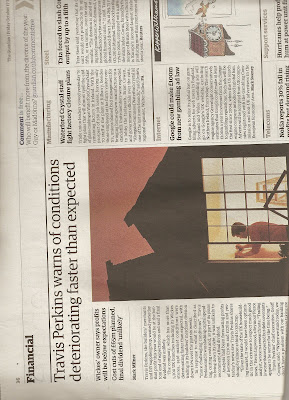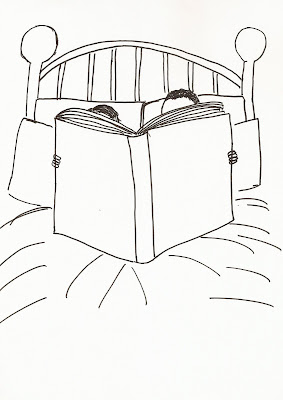
Wednesday, October 15, 2008
The History of Political Cartoon
When we hear the word cartoon, our minds naturally and quite automatically would wonder off into some sort of Disney, or Warner Brother’s animations. Though these are cartoons, they are but a very tiny and limited depiction of what cartoon really is.
The word Cartoon has a number of meanings. Cartoon found in the Italian language ‘cartone’ or in Dutch ‘karton’ is actually directly defined as strong, heave paper or pasteboard. An example of a very early form of cartoon can be found in the anti-Semitic Drawing (Source A) dated all the way back to 1233. This form of art was around the time extremely rare, and would not be common till the 16thC. Though still quite early on in time this piece was already politically orientated. It wasn’t really until the year 1517, when the Protestant Reformation occurred that cartoons wear really taken advantage of. Come the 18thC, cartoon was really out there, coming quite possible the biggest form of mass communication. And of course with the invention of printing press, came the birth of circular media.
dated all the way back to 1233. This form of art was around the time extremely rare, and would not be common till the 16thC. Though still quite early on in time this piece was already politically orientated. It wasn’t really until the year 1517, when the Protestant Reformation occurred that cartoons wear really taken advantage of. Come the 18thC, cartoon was really out there, coming quite possible the biggest form of mass communication. And of course with the invention of printing press, came the birth of circular media.
Cartoons originally were not seen as finished work, in fact, the early samples of cartoon were known as modellos. Modellos were there beginning part of what would eventually turn into a painting masterpiece of some sort. Primary that would be a fresco, painting, tapestry or stained glass. But somewhere along the way the audiences developed an eye for the preparatory part of a masterpiece, from there came the birth of cartoon.
The Raphael Cartoons are a very famous selection of work which are also seen to be early samples of cartoon. Though originally a set of ten pieces, these could be seen as one of the first series, strip, of comic cartoons. Taken from the gospels and Acts of the Apostles, of the bible, these images tell a continual story from one panel to the there. Of course they were not originally just paintings, they were modellos for tapestry. Later Charles I, then still a prince purchased seven of the ten, and had then brought to Britain, where it remains till this day. Today the Raphael Cartoons hang in the Victoria &Hall.


When we hear the word cartoon, our minds naturally and quite automatically would wonder off into some sort of Disney, or Warner Brother’s animations. Though these are cartoons, they are but a very tiny and limited depiction of what cartoon really is.
The word Cartoon has a number of meanings. Cartoon found in the Italian language ‘cartone’ or in Dutch ‘karton’ is actually directly defined as strong, heave paper or pasteboard. An example of a very early form of cartoon can be found in the anti-Semitic Drawing (Source A)
 dated all the way back to 1233. This form of art was around the time extremely rare, and would not be common till the 16thC. Though still quite early on in time this piece was already politically orientated. It wasn’t really until the year 1517, when the Protestant Reformation occurred that cartoons wear really taken advantage of. Come the 18thC, cartoon was really out there, coming quite possible the biggest form of mass communication. And of course with the invention of printing press, came the birth of circular media.
dated all the way back to 1233. This form of art was around the time extremely rare, and would not be common till the 16thC. Though still quite early on in time this piece was already politically orientated. It wasn’t really until the year 1517, when the Protestant Reformation occurred that cartoons wear really taken advantage of. Come the 18thC, cartoon was really out there, coming quite possible the biggest form of mass communication. And of course with the invention of printing press, came the birth of circular media.Cartoons originally were not seen as finished work, in fact, the early samples of cartoon were known as modellos. Modellos were there beginning part of what would eventually turn into a painting masterpiece of some sort. Primary that would be a fresco, painting, tapestry or stained glass. But somewhere along the way the audiences developed an eye for the preparatory part of a masterpiece, from there came the birth of cartoon.
The Raphael Cartoons are a very famous selection of work which are also seen to be early samples of cartoon. Though originally a set of ten pieces, these could be seen as one of the first series, strip, of comic cartoons. Taken from the gospels and Acts of the Apostles, of the bible, these images tell a continual story from one panel to the there. Of course they were not originally just paintings, they were modellos for tapestry. Later Charles I, then still a prince purchased seven of the ten, and had then brought to Britain, where it remains till this day. Today the Raphael Cartoons hang in the Victoria &Hall.




Another example would be ‘A Rake’s Progress’. A series of eight paintings produced between 1732-33, by artist William Hogarth. The panels tell a story about the young Tom Rakewell who was the son of a rich merchant. He was heir to his father’s riches of which he came into, one would say rather quickly and spent it lavishly on prostitutes and gambling. He would then later find himself in prison and eventually went mad and died.

Cartoon even from the very early year was for the most part a political tool. From the 18th C when it had become more commonly know, in Britain, artists such as Thomas Rowlandson and James Gillray, were two of many who became very bold and confident with their political opinions, using cartoon to poke fun matters of the period, leading the way for the next generation; the likes of George Cruikshank. While that was happening in Britain however, the French had already come up wit what would be the first weekly media circular, ‘'La Caricature' ‘ which was crushed after the first four years but was quickly replaced by a daily released newspaper, 'Le Charivari , which featured new cartoons everyday, and lived a full five years. The cartoonist of these cartoons did face imprisonment as his opinions were not taken so likely by authorities.
The idea however of printing a regular newspaper caught on very quickly around Europe Here in Britain though, it had lead to the birth of ‘Punch’ and artists such as John Leech who’s work as the first to actually be referred to as cartoon, rose to the surface.
Many influential artists were then introduced, as the 19thC rolled in, and the printing of daily newspapers were becoming increasingly popular.
The idea however of printing a regular newspaper caught on very quickly around Europe Here in Britain though, it had lead to the birth of ‘Punch’ and artists such as John Leech who’s work as the first to actually be referred to as cartoon, rose to the surface.
Many influential artists were then introduced, as the 19thC rolled in, and the printing of daily newspapers were becoming increasingly popular.
Subscribe to:
Comments (Atom)









































